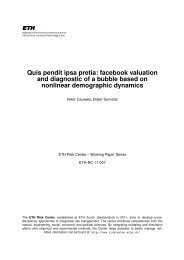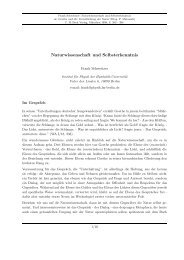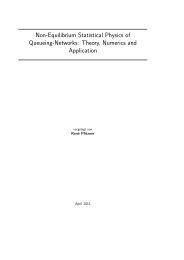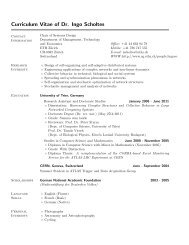Using Laboratory Experiments to Study Law and Crime - Chair of ...
Using Laboratory Experiments to Study Law and Crime - Chair of ...
Using Laboratory Experiments to Study Law and Crime - Chair of ...
Create successful ePaper yourself
Turn your PDF publications into a flip-book with our unique Google optimized e-Paper software.
This mechanism is difficult <strong>to</strong> test in the field. As described above, in field settings, it iseasier for researchers <strong>to</strong> get information about policy than about actual enforcement efforts bycontrol personnel. Relatedly, it is difficult <strong>to</strong> get data on <strong>of</strong>fenders’ reactions <strong>to</strong> actualenforcement levels. Further, it is difficult <strong>to</strong> observe the dynamic interplay <strong>of</strong> behaviors in thefield. These likely data limitations in conjunction with the many other fac<strong>to</strong>rs that may covarymeans that it is very difficult <strong>to</strong> track the feedback loops between criminal activity <strong>and</strong> controlefforts. In addition, in the field it is difficult <strong>to</strong> solve the endogeneity problem: Do high crimerates affect the level <strong>of</strong> punishment severity or does punishment severity drive the level <strong>of</strong>crime? In the labora<strong>to</strong>ry, these methodological concerns can be addressed.Rauhut (2009) conducted one experiment that manipulated the severity <strong>of</strong> punishment<strong>and</strong> another one that manipulated the incentives for law enforcement <strong>to</strong> pursue criminals (Rauhut2010). Because the labora<strong>to</strong>ry setting allowed him <strong>to</strong> manipulate punishment severity, we knowthat the crime rate did not cause changes in punishment severity. In addition, Rauhut was able <strong>to</strong>measure the behavior <strong>of</strong> both <strong>of</strong>fenders <strong>and</strong> control agents – something that is <strong>of</strong>ten difficult <strong>to</strong>do in natural settings – so that he could track the feedback loops between crime <strong>and</strong> control.Both experiments had a similar structure. There were two citizens <strong>and</strong> two law enforcers.Participants were r<strong>and</strong>omly assigned <strong>to</strong> be in either the citizen or the law enforcer position. Theparticipants interacted with each other for 30 rounds. On each round, citizens had theopportunity <strong>to</strong> steal money from each other. Also on each round, law enforcers were able <strong>to</strong>investigate crime – that is, <strong>to</strong> determine whether theft occurred. <strong>Law</strong> enforcers earned money bycatching criminal citizens <strong>and</strong> criminal citizens were subject <strong>to</strong> monetary fines.What happened? In Experiment 1, increasing the severity <strong>of</strong> punishment led <strong>to</strong> lowerrates <strong>of</strong> enforcement – when punishment was low, the average enforcement rate was 54%; whenpunishment was increased, the average enforcement rate dropped <strong>to</strong> 36%. This effect wassignificant at the 5 % level (Rauhut, 2009).Increasing the severity <strong>of</strong> punishment also discouraged theft. When punishment severity18







